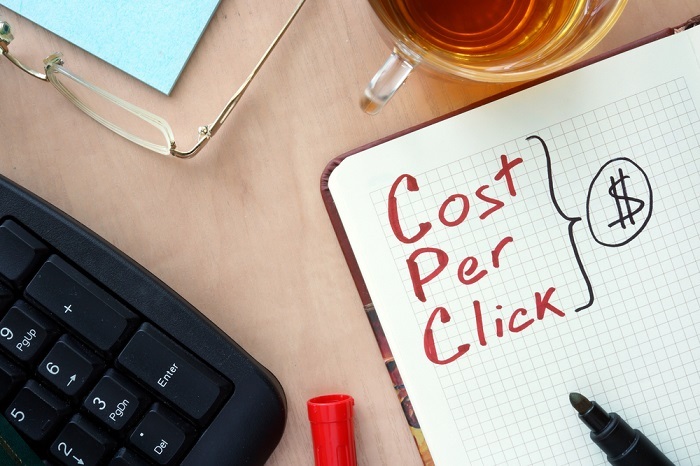
 Data Structure
Data Structure Networking
Networking RDBMS
RDBMS Operating System
Operating System Java
Java MS Excel
MS Excel iOS
iOS HTML
HTML CSS
CSS Android
Android Python
Python C Programming
C Programming C++
C++ C#
C# MongoDB
MongoDB MySQL
MySQL Javascript
Javascript PHP
PHP
- Selected Reading
- UPSC IAS Exams Notes
- Developer's Best Practices
- Questions and Answers
- Effective Resume Writing
- HR Interview Questions
- Computer Glossary
- Who is Who
What is CPC in Digital Marketing?
A cost-per-click is a type of advertising in which an advertiser pays for every click that they receive on a website. It is commonly used to determine the costs of showing users advertisements on various platforms, such as the Google Display Network and search engines. When it comes to choosing the right conversion bidding strategy, CPC is a crucial factor that can affect the effectiveness of your campaign.

The cost-per-click model is used by websites to determine how much they should charge advertisers for displaying ads. It takes into account how many people click on the ad. The CPM model is the most common type of ad pricing. It charges advertisers regardless of how many people click on the ad.
Understanding Cost Per Click
Cost-per-click advertising is commonly used by advertisers. They set a daily budget and then automatically remove their ads from a website's rotation once their budget has been reached. For instance, if a website charges an advertiser $100 for a thousand click-throughs, they would be removed from the site's rotation after reaching their budget.
A third-party network is often used by publishers to connect with advertisers. Your cost-per-click (CPC) is a vital part of any search advertising campaign. It determines how successful your ads are and how much you should be paying. When you bid on a keyword, it will determine which ad will appear on the search results page of a particular search engine. One of the most common tools for running these types of ads is Google Ads.
What Types of Ads Are Involved in the Cost Per Click?
Cost-per-click (CPC) is a calculation used to calculate the total cost of an ad campaign, which includes various types of text, social media, and rich-media ads. Some of these are only shown on certain networks, like the Google Display Network and the Google Search Network. Some of the common AD types involved in CPC are mentioned below ?
Text ads
LinkedIn ads
Image ads
Shopping ads
Video ads
Facebook ads
Twitter promoted tweets
Instagram ads
How Much Does One Click in a CPC Cost?
A click costs nothing more than what you're prepared to spend through a bidding process. For instance, you can bid $1 for every click on Google Ads, and the system will evaluate your ad and charge you nothing more than that. However, some caveats apply.
Google Ads will give you a discount if your ad quality score is higher. This is based on how relevant your ad is to the search terms that it's used. Adjustments will be made for other factors.
How Do I Calculate the Cost Per Click?
The cost per click is a calculation that shows the total cost of a paid advertisement campaign divided by the number of clicks. For instance, if you bid on keywords using Google AdWords, the tool will show you the cost per click for those words.
Formula of CPC = Ad cost/number of clicks
The average cost per click and the maximum cost per click are some of the key metrics that are related to the cost per click of paid advertisements. There are various strategies that can be used in Google AdWords to increase the cost per click.
Factors considered for evaluating an ad are ?
Ad Rank ? The ad rank is a score that determines which ad will appear on the search results page of Google. It is based on various factors, such as the quality of the ad, the amount of money that the bidder has invested, and the users' search intent.
Quality Score ? The Quality Score is a tool that lets you compare the effectiveness of your ad against those of other ads. It takes into account various factors, such as the expected click-through rate and the relevance of the ad to the users.
How Can I Decrease the Cost Per Click?
When it comes to advertising, you have to plan ahead to avoid overpaying for each click. One of the most important steps that you can take to ensure that you are not spending too much is to create a strategy that will allow you to raise your quality score.
Your Quality Score is a vital part of any website's success, and it can help boost your click-through rates and reduce your costs.
Expected clickthrough rate ? The expected clickthrough rate is the sum of all the factors that affect your ad's effectiveness. You can modify the ad's features and benefits to make it more attractive to your target audience.
Landing page experience ? A well-designed landing page is one of the most important factors that a website's users will consider when they click on an ad. It should be able to provide a compelling and relevant experience, and it should load fast on mobile and computers.
Ad relevance ? Your ad should be relevant to your target audience. You should analyze the results of search queries to find out what words are most likely to be used by your audience.
Keyword Search
It's important to have keywords in your ads to get people to your website. There are a variety of techniques that you can try to optimize your ads for search engines.
Targeting ? Your ad should be designed to target your audience based on their search query.
Splitting ? Split your ads into groups so they can be easily matched to other results.
Grouping ? Creating a theme for your products or services can be done by grouping them into groups. For instance, you can create a set of headphones that are designed to be grouped together to target specific audiences.
Conclusion
In the offline world, demographic targeting was done by the magazine industry. This allowed advertisers to reach a specific demographic audience.
The rise of the internet led to the development of pay-per-click advertising. It allowed advertisers to reach a specific audience by providing them with an actionable link.
The sophistication of the software used to create and buy ad space has increased. One of the biggest concerns of advertisers is the accuracy of the reports that they receive regarding the number of people that they reach.

